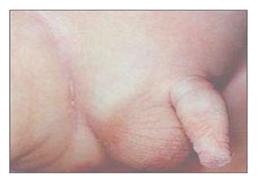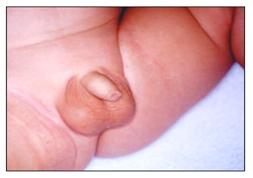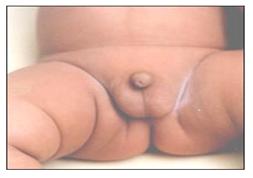신생아의 외부생식기(바깥 생식기/외음부), External genitalia of newborn infants

사진2-186.모체와 태반에서 받은 에스트로겐 등 여성 호르몬의 영향으로 신생 여아들의 음핵이 커져있다. 대음순도 커져있고 외음부의 색깔도 짙다. 이 모두 정상적인 생리 현상이다.
Copyright ⓒ 2011 John Sangwon Lee, MD., FAAP

사진2-187.분만 중 질 산도의 압력에 눌려 음낭이 부었다.
이것도 자연적으로 곧 회복된다.
Copyright ⓒ 2011 John Sangwon Lee, MD., FAAP
- 태어나기 전 태아는 모체와 태반에서 정상적으로 에스트로젠(에스트로겐) 등 여성 호르몬을 공급받는다.
- 갓 태어나서 생후 1∼2주까지 신생 여아들의 질에서 달걀 흰자위 비슷한 점액이 정상적으로 분비될 수 있다.
- 이런 분비물은 생후 1∼2주정도 지나면 더 이상 나오지 않는 것이 보통이다.
- 생후 3∼7일경 일부 신생 여아들의 자궁에서 피가 조금 나와 기저귀에 피가 묻을 수 있다. 이것도 대개 정상이다(사진 2-188 참조).
- 신생 남아들의 고환이 양쪽 음낭 속에 한 개씩 들어있다.
- 음낭 속에 있는 고환을 손으로도 만져 볼 수 있다.
- 고환이 음낭 속에 정상적으로 들어 있지만 어떤 때는 음낭 속에 있던 한쪽, 또는 양쪽 고환이 샅(사타구니)의 위에 서혜관 속으로 일시적으로 올라가 잠시 있다가 음낭 속으로 다시 내려 올 수 있다.
- 이 때문에 어떤 때는 고환이 음낭 속에서 일시적으로 만져지지 않을 수 있다.
- 태어날 때부터 어떤 신생아의 고환이 음낭 속에 들어 있지 않고 복강 내, 또는 서혜관 속에 계속 머물러 있을 수 있다.
- 이런 고환을 잠재 고환이라 한다.
- 잠재 고환 중 일부는 태어난 후 자연적으로 음낭 속으로 내려온다.
- 드물게 신생아의 음낭 속에 고환이 들어있으면서 그 음낭 속에 체액이 괼 수 있다. 이것을 음낭수종이라 한다(음낭수종 참조).
- 음낭의 바로 위 부위에 있는 사타구니(샅) 부위를 서혜부라 한다.
- 탈장이 서혜부의 한쪽, 또는 양쪽에 있을 수 있다.
- 이것을 서혜부 탈장이라 한다.
- 서혜부 탈장이 있으면 서혜부가 불룩하게 나와 있을 수 있다. (부모도 반의사가 되어야한다-소아가정간호 백과-제 9권 소아청소년 소화기 질환-서혜부 탈장 참조)
- 서혜부 탈장은 신생 남녀아들이나 신생아기 이후 소아들, 또는 성인들에게도 생길 수 있다.
- 갓 태어난 모든 신생 남아들의 자지의 음경귀두 부분은 음경귀두피부(포피)로 꼭 싸여있는 것이 정상이다.
- 이 피부를 포피라고 한다.
- 자지(음경)의 귀두 부분에서 음경귀두 포피를 일부러 까 젖혀 줄 필요가 없다.
- 포경수술을 꼭해서 음경귀두 포피를 떼어낼 필요도 없다.
- 포경수술을 받아 생긴 수술 환부가 다 나을 때까지 의사의 지시에 따라 치료한다(포경수술 참조).
- 신생아의 식도, 위, 소장, 대장 등의 폐쇄증을 참조.
- 저자는 있는 그대로 성장하도록 포경수술을 권장하지 않는다.

사진 2-188. 1주된 신생 여아의 자궁 출혈
기저귀에 묻은 피는 자궁에서 나온 출혈이다.
Copyright ⓒ 2011 John Sangwon Lee, MD., FAAP

사진 2-189. 포경수술을 받지 않은 신생 남아의 자지
정상적인 자지의 크기는 차이가 많다.
Copyright ⓒ 2011 John Sangwon Lee, MD., FAAP

사진 2-190. 포경수술을 받은 신생 남아의 자지. 여기서 포경수술 후 붉은 귀두를 볼 수 있다.
Copyright ⓒ 2011 John Sangwon Lee, MD., FAAP

사진 2-191. 포경수술을 받지 않은 신생 남아의 정상 자지
Copyright ⓒ 2011 John Sangwon Lee, MD., FAAP

사진 2-192. 포경수술을 받지 않은 신생 남아의 정상 자지. 사진 2-189와 이 사진에서 볼 수 있는 자지의 크기가 다르다. 그러나 모두 정상이다.
Copyright ⓒ 2011 John Sangwon Lee, MD., FAAP
External genitalia of newborn infants 신생아의 외부생식기(바깥 생식기/외음부)

Photo 2-186. New girls’ clitoris is enlarged due to the influence of female hormones such as estrogen received from the mother and placenta. The large labium is also enlarged and the color of the vulva is also dark. All of these are normal physiological phenomena. Copyright ⓒ 2011 John Sangwon Lee, MD., FAAP

Picture 2-187. During delivery, the scrotum was swollen due to pressure from the vaginal birth canal. This, too, will recover naturally soon. Copyright ⓒ 2011 John Sangwon Lee, MD., FAAP
- Before birth, the fetus normally receives female hormones such as estrogen from the mother and placenta. From newborn to 1 to 2 weeks after birth, mucus similar to egg white can be secreted normally from the vagina of newborn girls.
- These secretions usually do not come out anymore after 1 to 2 weeks of life.
- Some newborn girls around the 3rd to 7th days of age may bleed a little from the womb and get blood on their diapers.
- This is also usually normal (see photo 2-188).
- The testicles of new boys are contained in each scrotum, one at a time. You can even touch the testicles in the scrotum with your hands.
- The testicles are normally contained in the scrotum, but sometimes one or both testicles, which were in the scrotum, can temporarily rise above the groin into the groin, and then come back down into the scrotum.
- Because of this, in some cases the testicles may not be touched temporarily in the scrotum.
- From birth, the testicles of some newborns are not contained in the scrotum and may remain in the abdominal cavity or in the groin.
- These testicles are called latent testicles. Some of the latent testicles naturally descend into the scrotum after birth. Rarely, a newborn’s scrotum may contain testicles and fluid may squeeze into the scrotum.
- This is called scrotal edema (see Scrotal edema).
- The groin located just above the scrotum is called the groin. The hernia may be on one or both sides of the groin. This is called a inguinal hernia.
- If your newborn has a groin hernia, the groin may be protruding. (Parents should also be at least the half-doctors-Refer to Encyclopedia of Child and Family Nursing-Volume 9, Children and Adolescents Digestive Diseases-Inguinal Hernia)
- Inguinal hernias can also occur in newborn boys and girls, post-natal children, or even adults. It is normal that the penis glans part of the cock of all newborn boys is tightly wrapped with the skin of the penis glans (foreskin). This skin is called the foreskin.
- There is no need to deliberately lift the glans of the penis from the glans of the cock (penis). There is no need to remove the foreskin of the glans penis by performing circumcision.
- Treat the affected area caused by circumcision according to the doctor’s instructions until all healed (see Circumcision).
- See atresia of the esophagus, stomach, small intestine, and large intestine in newborns. The authors do not recommend circumcision to grow as is.

Photo 2-188. Uterine bleeding in a 1-week-old newborn girl. Blood on the diaper is bleeding from the uterus. Copyright ⓒ 2011 John Sangwon Lee, MD., FAAP

Photo 2-189. The cock of a newborn boy who has not undergone circumcision. There are many differences in the size of a normal cock. Copyright ⓒ 2011 John Sangwon Lee, MD., FAAP

Photo 2-190. The cock of a newborn boy who has undergone circumcision. Here, you can see the red glans after circumcision. Copyright ⓒ 2011 John Sangwon Lee, MD., FAAP

Photo 2-191. Normal cock of a newborn boy who has not undergone circumcision. Copyright ⓒ 2011 John Sangwon Lee, MD., FAAP

Photo 2-192. The normal cock of a newborn boy who has not undergone circumcision.

Picture 2-189 is different from the size of the cock. you can see in this picture. But all is normal. Copyright ⓒ 2011 John Sangwon Lee, MD., FAAP
출처 및 참조 문헌
- NelsonTextbook of Pediatrics 22ND Ed
- The Harriet Lane Handbook 22ND Ed
- Growth and development of the children
- Red Book 32nd Ed 2021-2024
- Neonatal Resuscitation, American Academy Pediatrics
- www.drleepediatrics.com 제1권 소아청소년 응급 의료
- www.drleepediatrics.com 제2권 소아청소년 예방
- www.drleepediatrics.com 제3권 소아청소년 성장 발육 육아
- www.drleepediatrics.com 제4권 모유,모유수유, 이유
- www.drleepediatrics.com 제5권 인공영양, 우유, 이유식, 비타민, 미네랄, 단백질, 탄수화물, 지방
- www.drleepediatrics.com 제6권 신생아 성장 발육 육아 질병
- www.drleepediatrics.com제7권 소아청소년 감염병
- www.drleepediatrics.com제8권 소아청소년 호흡기 질환
- www.drleepediatrics.com제9권 소아청소년 소화기 질환
- www.drleepediatrics.com제10권. 소아청소년 신장 비뇨 생식기 질환
- www.drleepediatrics.com제11권. 소아청소년 심장 혈관계 질환
- www.drleepediatrics.com제12권. 소아청소년 신경 정신 질환, 행동 수면 문제
- www.drleepediatrics.com제13권. 소아청소년 혈액, 림프, 종양 질환
- www.drleepediatrics.com제14권. 소아청소년 내분비, 유전, 염색체, 대사, 희귀병
- www.drleepediatrics.com제15권. 소아청소년 알레르기, 자가 면역질환
- www.drleepediatrics.com제16권. 소아청소년 정형외과 질환
- www.drleepediatrics.com제17권. 소아청소년 피부 질환
- www.drleepediatrics.com제18권. 소아청소년 이비인후(귀 코 인두 후두) 질환
- www.drleepediatrics.com제19권. 소아청소년 안과 (눈)질환
- www.drleepediatrics.com 제20권 소아청소년 이 (치아)질환
- www.drleepediatrics.com 제21권 소아청소년 가정 학교 간호
- www.drleepediatrics.com 제22권 아들 딸 이렇게 사랑해 키우세요
- www.drleepediatrics.com 제23권 사춘기 아이들의 성장 발육 질병
- www.drleepediatrics.com 제24권 소아청소년 성교육
- www.drleepediatrics.com 제25권 임신, 분만, 출산, 신생아 돌보기
- Red book 29th-31st edition 2021
- Nelson Text Book of Pediatrics 19th- 21st Edition
- The Johns Hopkins Hospital, The Harriet Lane Handbook, 22nd edition
- 응급환자관리 정담미디어
- Pediatric Nutritional Handbook American Academy of Pediatrics
- 소아가정간호백과–부모도 반의사가 되어야 한다, 이상원 저
- The pregnancy Bible. By Joan stone, MD. Keith Eddleman, MD
- Neonatology Jeffrey J. Pomerance, C. Joan Richardson
- Preparation for Birth. Beverly Savage and Dianna Smith
- 임신에서 신생아 돌보기까지. 이상원
- Breastfeeding. by Ruth Lawrence and Robert Lawrence
- Sources and references on Growth, Development, Cares, and Diseases of Newborn Infants
- Emergency Medical Service for Children, By Ross Lab. May 1989. p.10
- Emergency care, Harvey Grant and Robert Murray
- Emergency Care Transportation of Sick and Injured American Academy of Orthopaedic Surgeons
- Emergency Pediatrics A Guide to Ambulatory Care, Roger M. Barkin, Peter Rosen
- Quick Reference To Pediatric Emergencies, Delmer J. Pascoe, M.D., Moses Grossman, M.D. with 26 contributors
- Neonatal resuscitation Ameican academy of pediatrics
- Pediatric Nutritional Handbook American Academy of Pediatrics
- Pediatric Resuscitation Pediatric Clinics of North America, Stephen M. Schexnayder, M.D.
-
Pediatric Critical Care, Pediatric Clinics of North America, James P. Orlowski, M.D.
-
Preparation for Birth. Beverly Savage and Dianna Smith
-
Infectious disease of children, Saul Krugman, Samuel L Katz, Ann A.
- 제4권 모유, 모유수유, 이유 참조문헌 및 출처
- 제5권 인공영양, 우유, 이유, 비타민, 단백질, 지방 탄수 화물 참조문헌 및 출처
- 제6권 신생아 성장발육 양호 질병 참조문헌 및 출처
- 소아과학 대한교과서
-
Copyright ⓒ 2015 John Sangwon Lee, MD., FAAP
미국 소아과 전문의, 한국 소아청소년과 전문의 이상원 저 “부모도 반의사가 되어야 한다”-내용은 여러분들의 의사로부터 얻은 정보와 진료를 대신할 수 없습니다.
The information contained in this publication should not be used as a substitute for the medical care and advice of your doctor. There may be variations in treatment that your doctor may recommend based on individual facts and circumstances. “Parental education is the best medicine.”